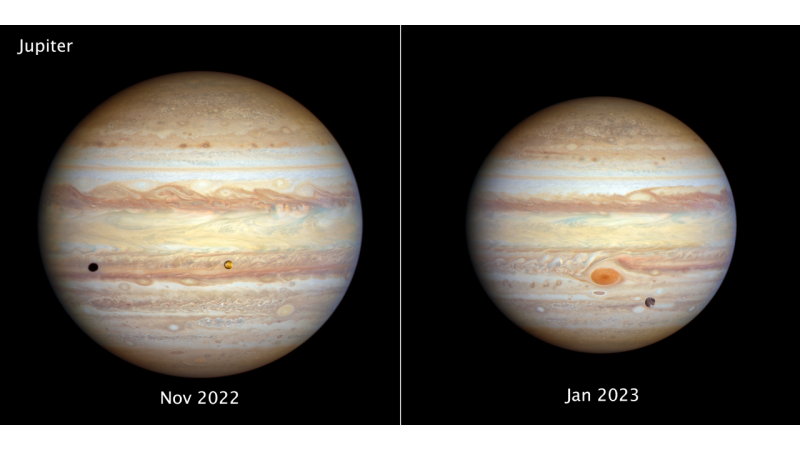
Original article published by NASA on March 23, 2023. Edits by EarthSky.
How’s the weather on Jupiter and Uranus?
Hubble – an interplanetary meteorologist – keeps track of changing weather and seasons on the planets. Jupiter’s weather is driven from inside-out as more heat percolates up from its interior than it receives from the sun. This heat indirectly drives color change cycles, highlighting a system of alternating cyclones and anticyclones.
On the other hand, Uranus has seasons that pass by at a snail’s pace, because it takes 84 years to complete one orbit about the sun. Also, the seasons are extreme because Uranus is tipped on its side. So as summer approaches in the northern hemisphere, Hubble sees a growing polar cap of high-altitude photochemical haze that looks similar to smog over cities on Earth.
Last chance to get a moon phase calendar! Only a few left. On sale now.
Forecast for Jupiter
In the view of Jupiter below, the left image is from November 12, 2022. You can see a prominent string of alternating storms, forming a “vortex street”. This is a wave pattern of nested anticyclones and cyclones, locked together like in a machine with alternating gears moving clockwise and counterclockwise. If the storms get close enough to each other in an unlikely merger, they could build an even larger storm, potentially rivaling the current size of the Great Red Spot. The staggered pattern of anticyclones and cyclones prevents individual storms from merging. These storms have sprung up in the last decade. Strong color differences indicate Hubble is seeing different cloud heights and depths as well.
In addition, Io photobombed this view of Jupiter, casting a shadow. The volcanic sulfur takes on various hues at different temperatures, which is why Io’s surface is so colorful.
The image at right, from January 6, 2023, shows Jupiter and the legendary Great Red Spot. The planet looks smaller because Jupiter was farther then. Though this vortex is big enough to swallow Earth, it has actually shrunken to the smallest size it has ever been over observation records dating back 150 years. Jupiter’s icy moon Ganymede transits the giant planet at lower right. Slightly larger than Mercury, Ganymede is the largest moon in the solar system. It is a cratered world with a mainly water-ice surface with apparent glacial flows driven by internal heat.

The forecast for Uranus
Planetary oddball Uranus rolls on its side around the sun as it follows an 84-year orbit. Its weirdly tipped “horizontal” rotation axis of eight degrees off the plane of its orbit means that – for stretches of time lasting up to 42 years – parts of one hemisphere are completely without sunlight. When the Voyager 2 spacecraft visited during the 1980s, the planet’s south pole was pointed almost directly at the sun. However, Hubble’s latest view shows the northern pole now tipping toward the sun.
The image of Uranus (below, left) is from 2014. That was seven years after northern spring equinox, when the sun was shining directly over the planet’s equator. At this time, the planet had multiple small storms and even some faint cloud bands.
The image of Uranus (below, right) is from November 10, 2022. Uranus’ north pole shows a thickened photochemical haze that looks similar to smog over cities. Also, several little storms are near the edge of the polar-haze boundary. Hubble has been tracking the size and brightness of the north polar cap, and it continues to get brighter year after year. Multiple effects control how the atmospheric polar cap changes with the seasons. As northern summer solstice approaches in 2028, the cap may grow brighter and will be aimed directly toward Earth. At that time, we’ll get good views of the rings and north pole; the ring system will then appear face-on.

Bottom line: The Hubble Space Telescope keeps an eye on the planets in space, watching the weather and seasons change on planets such as Jupiter and Uranus.











